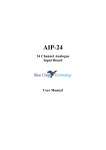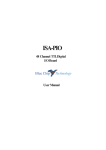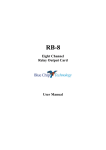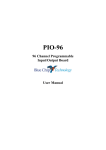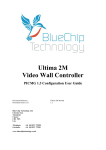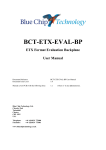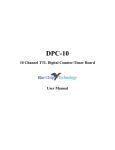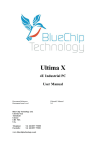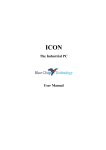Download 8 Channel Analogue Output Board User Manual
Transcript
AOP-8 8 Channel Analogue Output Board User Manual AOP-8 User Manual Document Part N° Document Reference Document Issue Level 0127-1011 0127-1011.Doc 1.0 Manual covers PCBs identified AOP-8 Rev. B All rights reserved. No part of this publication may be reproduced, stored in any retrieval system, or transmitted, in any form or by any means, electronic, mechanical, photocopied, recorded or otherwise, without the prior permission, in writing, from the publisher. For permission in the UK contact Blue Chip Technology. Information offered in this manual is correct at the time of printing. Blue Chip Technology accepts no responsibility for any inaccuracies. This information is subject to change without notice. All trademarks and registered names acknowledged. Blue Chip Technology Ltd., Chowley Oak, Tattenhall Chester, Cheshire CH3 9EX. Telephone : 01829 772000 Facsimile : 01829 772001. Amendment History Issue Level 0.1 1.0 Issue Date 08.05.89 12.09.97 Author JSD SEJ Amendment Details First draft Update window front cover and logo. See ECN 98/084 Contents OUTLINE DESCRIPTION .................................................................. 1 1.0 SPECIFICATIONS ....................................................................... 2 1.1 Electrical Specification ............................................................. 2 1.2 Physical Specification .............................................................. 2 Electromagnetic Compatibility (EMC)............................................. 2 2.0 USER ADJUSTMENTS ................................................................ 5 2.1 Selecting the Base Address...................................................... 5 2.2 Port Map .................................................................................. 6 3.0 ELECTRICAL OPTIONS .............................................................. 8 3.1 Output Connections.................................................................. 8 3.2 Connector Pin Details............................................................... 9 4.0 OPERATING GUIDE.................................................................. 10 4.1 Using the Device.................................................................... 10 4.2 Programming Guide ............................................................... 10 4.3 User Options .......................................................................... 11 5.0 COMMERCIAL DATA ACQUISITION PACKAGES ................... 12 5.1 Use of the AOP-8 Board with ASYST .................................... 12 APPENDIX A ................................................................................... 13 APPENDIX B - PC MAPS................................................................. 15 PC/XT/AT I/O Address Map ......................................................... 15 PC/XT Interrupt Map .................................................................... 16 PC/AT Interrupt Map .................................................................... 17 Blue Chip Technology Ltd. 01271011.doc Outline Description Page 1 OUTLINE DESCRIPTION This card provides 8 analogue outputs in the range 0-10V, at up to 10mA per channel. Blue Chip Technology Ltd. 01271011.doc Page 1 Page 2 Specifications 1.0 SPECIFICATIONS 1.1 Electrical Specification Number of Outputs Max Output Voltage Max Load Current 1.2 8 10.24V D.C. 10mA D.C. Physical Specification Height Width Depth 107mm 15mm 132mm Electromagnetic Compatibility (EMC) This product meets the requirements of the European EMC Directive (89/336/EEC) and is eligible to bear the CE mark. It has been assessed operating in a Blue Chip Technology Icon industrial PC. However, because the board can be installed in a variety of computers, certain conditions have to be applied to ensure that the compatibility is maintained. It meets the requirements for an industrial environment (Class A product) subject to those conditions. • The board must be installed in a computer system which provides screening suitable for the industrial environment. • Any recommendations made by the computer system manufacturer/supplier must be complied with regarding earthing and the installation of boards. • The board must be installed with the backplate securely screwed to the chassis of the computer to ensure good metal-to-metal (i.e. earth) contact. Page 2 01271011.doc Blue Chip Technology Ltd. Specifications Page 3 • Most EMC problems are caused by the external cabling to the board. Analogue boards fitted with IDC ribbon cable connectors on the metal mounting bracket require particularly careful installation of the external cabling. It is imperative that any external cabling to the board is totally screened, and that the screen of the cable connects to the metal end bracket of the board and hence to earth. The cabling must be totally screened; the type of ribbon cable which is rolled to a round form with a braided wire screen is best. Standard ribbon cable will not be adequate unless it is contained wholly within the cabinetry housing the industrial PC. Keep the unscreened section as short as possible. The mounting bracket of the board includes a captive nut as an screen earth point. Connect the screen of the cable to this by the shortest possible wire. • If difficulty with interference is experienced the cable should also be fitted with a ferrite clamp as close possible to the connector. The preferred type is the Chomerics clip-on style, type H8FE-1004-AS. • It is recommended that cables are kept as short as possible, particularly when dealing with low level signals. • Ensure that the screen of the external cable is bonded to a good RF earth at the remote end of the cable. Failure to observe these recommendations may invalidate the EMC compliance. Warning This is a Class A product. In a domestic environment this product may cause radio interference in which case the user may be required to take adequate measures. Blue Chip Technology Ltd. 01271011.doc Page 3 Page 4 Specifications EMC Specification A Blue Chip Technology Icon industrial PC fitted with this card meets the following specification: Emissions EN 55022:1995 Radiated Class A Conducted Class A & B Immunity EN 50082-1:1992 incorporating: Electrostatic Discharge IEC 801-2:1984 Performance Criteria B Radio Frequency Susceptibility IEC 801-3:1984 Performance Criteria A Fast Burst Transients IEC 801-4:1988 Performance Criteria B Page 4 01271011.doc Blue Chip Technology Ltd. User Adjustments 2.0 USER ADJUSTMENTS 2.1 Selecting the Base Address Page 5 The board may be located in any 62 pin slot in the PC motherboard but must be set up to appear at a specified position (or ‘address’) in the port map. Available positions are shown in the IBM-PC Technical Reference Guide. However, for those who do not possess a copy of this document a good place is the location normally allocated to the prototyping card as supplied by IBM. This address is 300 Hex or 768 decimal. All Blue Chip Technology cards are preset to this address at the factory. However, no two devices should be used while set to the same address since contention will occur and neither board will work. If your machine contains a card with conflicting address then another reasonably safe address is 200 to 21F (Hex). A set of links is provided on the board to set the base address of the board within the IBM-PC port map. The address is in binary with the presence of a link representing a 0 and the absence of a link representing a 1. To set the base address to 768 Decimal (300 Hex) set the following pattern on the links as indicated: Blue Chip Technology Ltd. 01271011.doc Page 5 Page 6 User Adjustments Figure 1 - Selecting the Base Address Note: View board with back panel on RHS. Middle 6 Bits of port address on links. MSB LSB 10 20 40 80 100 200 More example addresses are shown in Appendix A. Note: No two cards must occupy the same address. 2.2 Port Map The AOP card has up to eight 12 bit analogue output channels. These are arranged as up to eight pairs of 8 bit ports. One port holds the 8 low bits and the other the 4 high bits of the desired 12 bit output value. This is shown below: Address Base + 0 Base + 1 Base + 2 Base + 3 Base + 4 Base + 5 Base + 6 Base + 7 Base + 8 Base + 9 Base + 10 Base + 11 Base + 12 Base + 13 Base + 14 Base + 15 Page 6 Write Channel 0 low 8 bits Channel 0 high 4 bits Channel 1 low 8 bits Channel 1 high 4 bits Channel 2 low 8 bits Channel 2 high 4 bits Channel 3 low 8 bits Channel 3 high 4 bits Channel 4 low 8 bits Channel 4 high 4 bits Channel 5 low 8 bits Channel 5 high bits Channel 6 low bits Channel 6 high bits Channel 7 low bits Channel 7 high 4 bits 01271011.doc Read N/A N/A N/A N/A N/A N/A N/A N/A N/A N/A N/A N/A N/A N/A N/A UPDATE Blue Chip Technology Ltd. User Adjustments Page 7 For AOP-2, AOP-4 and AOP-6 all channels begin at 0 e.g. AOP-2 uses Base + 0 to Base + 3 other channels are unpopulated. 7 6 5 4 3 2 1 0 ADDRESS XX0H (W/O) CHANNELS 0 DATA (BITS 7-0) 7 6 5 4 3 2 1 0 ADDRESS XX1H (W/O) CHANNELS 0 DATA (BITS 11-8) Blue Chip Technology Ltd. 01271011.doc Page 7 Page 8 Electrical Options 3.0 ELECTRICAL OPTIONS 3.1 Output Connections A 50 way insulation displacement connector (IDC) is provided on the PC rear panel of the board for output signal connection. If access to individual channels is required, a 50 way IDC ribbon cable may be used to connect the outputs to a 50 way screw terminal block available from Blue Chip Technology as part number ST-24. The functions of the pins are shown in Section 3.2. When the connector is viewed from the back of the system, odd numbered pins are on the left and even numbered pins are on the right with pin 1 at the top of the connector. Pin Detail Pin Pin Ο . . . . . . Pin Pin 1 3 47 49 Ο Ο Ο Ο Ο Ο Ο Ο Ο Ο Ο Ο Ο Ο Ο Ο Pin Pin . . . . . . . Pin Pin 2 4 48 50 View with gold edge connectors downwards. Page 8 01271011.doc Blue Chip Technology Ltd. Electrical Options 3.2 Page 9 Connector Pin Details Function Channel 0 + ve Channel 1 + ve Channel 2 + ve Channel 3 + ve Channel 4 + ve Channel 5 + ve Channel 6 + ve Channel 7 + ve Analogue Ground Analogue Ground Analogue Ground Analogue Ground Analogue Ground Analogue Ground Analogue Ground Analogue Ground Analogue Ground Analogue Ground Analogue Ground Analogue Ground Analogue Ground Analogue Ground Analogue Ground Analogue Ground 0V Blue Chip Technology Ltd. Pin 1 o 3 o 5 o 7 o 9 o 11 o 13 o 15 o 17 o 19 o 21 o 23 o 25 o 27 o 29 o 31 o 33 o 35 o 37 o 39 o 41 o 43 o 45 o 47 o 49 o Pin o 2 o 4 o 6 o 8 o 10 o 12 o 14 o 16 o 18 o 20 o 22 o 24 o 26 o 28 o 30 o 32 o 34 o 36 o 38 o 40 o 42 o 44 6 o 46 o 48 o 50 01271011.doc Function Analogue Ground Analogue Ground Analogue Ground Analogue Ground Analogue Ground Analogue Ground Analogue Ground Analogue Ground Analogue Ground Analogue Ground Analogue Ground Analogue Ground Analogue Ground Analogue Ground Analogue Ground Analogue Ground Analogue Ground Analogue Ground Analogue Ground Analogue Ground Analogue Ground Analogue Ground Analogue Ground Analogue Ground 0V Page 9 Page 10 Operating Guide 4.0 OPERATING GUIDE 4.1 Using the Device The normal method of setting an output is: 1. 2. 3. Load data by writing to low byte port. Load data on writing to high NIBL port. Strobe data to output by reading UPDATE port. The digital to analogue converters used on this board contain a buffer and the data is initially written into this buffer without changing the output voltage. The output voltages are not altered until the UPDATE command is performed which transfers the data from all buffers to their respective output register without altering the data in the buffers. Thus single channels may be updated using an UPDATE command immediately after loading data for one channel, or several output signals may be changed simultaneously by first loading data into the relevant buffers and then issuing the UPDATE command. The procedure for a single output is illustrated in the software example. 4.2 Programming Guide The output signals may be set as shown in the following example using Microsoft BASIC A or GW BASIC: 10 20 30 40 50 60 70 INPUT BITS TOP BOT OUT OUT A ″Enter voltage required″:V = V*400 = INT(BITS/256) = INT (BITS-256xTOP) &H300,BOT &H301, TOP = INP (&H30F) ′Set bottom byte ′Set top NIBL This example assumes a standard board set for 2.5mV/bit or 0-10.24V output and sets only channel 0 as controlled by the ′OUT′ statements in lines 50 and 60. Page 10 01271011.doc Blue Chip Technology Ltd. Operating Guide 4.3 Page 11 User Options a. Grounding The analogue ground for the outputs can be linked to digital ground using a link option (LKB). When the link is fitted the two grounds are connected. Conversely with the link removed the grounds are allowed to float at different voltages up to +/- 0.6V under the clamping action of diodes D2 and D3. b. Calibration A 10V reference is generated for all channels from diode D1 and IC5. This voltage may be trimmed using RV5 or completely re-scaled by changing R1, R2 or D1. Individual channels can be trimmed by trimpots as follows: Channel 0 1 2 3 4 5 6 7 Blue Chip Technology Ltd. Trimpot Ref. RV2 RV1 RV7 RV6 RV4 RV3 RV9 RV8 01271011.doc Page 11 Page 12 Commercial Data Acquisition Packages 5.0 COMMERCIAL DATA ACQUISITION PACKAGES The Blue Chip Technology DOP-24 can be used with almost any data acquisition or control package that can write information directly to a PC output port. 5.1 Use of the AOP-8 Board with ASYST The board has been tested with and is installable as an IO.PORT digital device in the ASYST scientific software package by Macmillan Software Company. For more details about this package and other PC data acquisition software, please contact Blue Chip Technology. Whilst every effort has been taken to ensure that the information provided is accurate, Blue Chip Technology cannot assume responsibility for any errors in this manual or their consequences. Should any errors be detected, the company would greatly appreciate being informed of them. A policy of continuos product development is operated, resulting in the contents of this document being subject to change without notice. Page 12 01271011.doc Blue Chip Technology Ltd. Appendix A Page 13 APPENDIX A Note view board with back panel on RHS. Address Settings for Port 300H MSB LSB 10 40 20 80 100 200 Address Settings for Port 200H MSB LSB 10 20 40 80 100 200 Address Settings for Port 210H MSB LSB 10 Blue Chip Technology Ltd. 20 40 80 100 200 01271011.doc Page 13 Page 14 Appendix A Address Settings for Port 220H MSB LSB 10 20 40 80 100 200 Address Settings for Port 230H MSB LSB 10 Page 14 20 40 80 100 200 01271011.doc Blue Chip Technology Ltd. Appendix B Page 15 APPENDIX B - PC MAPS PC/XT/AT I/O Address Map Address Allocated to: 000-01F 020-03F 040-05F 060-06F 070-07F 080-09F 0A0-0BF 0F0 0F1 0F8-0FF 1F0-1F8 200-207 278-27F 2F8-2FF 300-31F 360-36F 378-37F 380-38F 3A0-3AF 3B0-3BF 3C0-3CF 3D0-3DF 3F0-3F7 3F8-3FF DMA Controller 1 (8237A-5) Interrupt Controller 1 (8259A) Timer (8254) Keyboard Controller (8742) Control Port B RTC and CMOS RAM, NMI Mask (Write) DMA Page Register (Memory Mapper) Interrupt Controller 2 (8259) Clear NPX (80287) Busy Reset NPX (80287) Numeric Processor Extension (80287) Hard Disk Drive Controller Reserved Reserved for Parallel Printer Port 2 Reserved for Serial Port 2 Reserved Reserved Parallel Printer Port 1 Reserved for SDLC Communications, Bisync 2 Reserved for Bisync 1 Reserved Reserved Display Controller Diskette Drive Controller Serial Port 1 Blue Chip Technology Ltd. 01271011.doc Page 15 Page 16 Appendix B PC/XT Interrupt Map Number Allocated to: NMI 0 1 2 3 Parity Timer Keyboard Reserved Asynchronous Communications (Secondary) SDLC Communications Asynchronous Communications (Primary) SDLC Communications Fixed Disk Diskette Parallel Printer 4 5 6 7 Page 16 01271011.doc Blue Chip Technology Ltd. Appendix B Page 17 PC/AT Interrupt Map Level Allocated to: CPU NMI CTLR 1 Parity or I/O Channel Check CTLR 2 IRQ 0 IRQ 1 IRQ 2 IRQ 8 IRQ 9 IRQ 10 IRQ 11 IRQ 12 IRQ 13 IRQ 14 IRQ 15 IRQ 3 IRQ 4 IRQ 5 IRQ 6 IRQ 7 Blue Chip Technology Ltd. (Interrupt Controllers) Timer Output 0 Keyboard (Output Buffer Full) Interrupt from CTLR 2 Real-time Clock Interrupt S/w Redirected to INT 0AH (IRQ 2) Reserved Reserved Reserved Co-processor Fixed Disk Controller Reserved Serial Port 2 Serial Port 1 Parallel Port 2 Diskette Controller Parallel Port 1 01271011.doc Page 17 Typical Methods of Interfacing from an AOP card to other Circuitry 5V OUT LM35 TEMP' SENSOR AOP P1/1 0V HEATER The Analogue Output card can be used as a voltage reference in a closed loop temperature monitoring circuit AOP FCLK P1/1 Vin Voltage to frequency The Analogue Output can be fed into a voltage to frequency converter



























